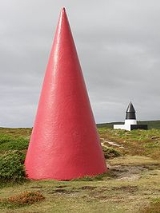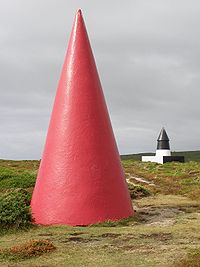
Runnel Stone
Encyclopedia
The Runnel Stone is a hazardous rock pinnacle
situated about a mile south of Gwennap Head
, Cornwall
, United Kingdom
that used to show above the surface at low water until a steamship struck it in 1923.
 A buoy
A buoy
currently marks the position of the Runnel Stone. It is topped with a flashing light and a bell which peals with the movement of the waves. It is also fitted with a whistle set in a tube, which emits a moaning sound when there is a good swell running. This mournful noise can be heard clearly from Gwennap Head
, drifting in from the sea, and adds to the eerie atmosphere of the clifftop in foggy conditions.
There are a pair of cone-shaped navigation markers
on Gwennap Head
, in line with the Runnelstone buoy. These are day markers warning vessels of the hazard of the Runnel Stone. The cone to the seaward side is painted red and the inland one is black and white. When at sea the black and white one should always be kept in sight in order to avoid the submerged rocks nearer the shore. If the black and white cone is completely obscured by the red cone then the vessel would be directly on top of the Runnel Stone. The black and white landmark was erected by the Corporation of Trinity House
in 1821 - an event recorded on a plaque on the back of the marker.
One nineteenth century attempt to attach a warning buoy to the Runnel Stone was led by the naval Lieutenant Hugh Goldsmith (nephew of the famous poet Oliver Goldsmith
) aboard the cutter HMS Nimble. After several unsuccessful attempts Lt. Goldsmith and a number of his crew turned their attention inland and succeeded in toppling the famous Logan Rock
from its precarious perch on the Treryn Dinas headland east of Porthcurno
.
At 3pm, 8 October 1923 the 6,000 ton SS City of Westminster bound from Belfast to Rotterdam with a cargo of South African maize knocked the top of the reef clean off. A total of 72 people were taken off by the Sennen and Penlee lifeboats. Today the remains lie in 30m of water, jammed into a gully on the eastern side of the stone.
and Lamorna
, the Runnel Stone is known as one of the best dive
sites in the whole of Cornwall. Diving must be carried out at slack water, which is about one and a half hours before high water at Newlyn
. The highlights include visibility of up to 20m, numerous wrecks, and anemones in a vast array of colours.
Rock (geology)
In geology, rock or stone is a naturally occurring solid aggregate of minerals and/or mineraloids.The Earth's outer solid layer, the lithosphere, is made of rock. In general rocks are of three types, namely, igneous, sedimentary, and metamorphic...
situated about a mile south of Gwennap Head
Gwennap Head
Gwennap Head is the most southerly headland on the south coast of the Penwith peninsula, Cornwall, United Kingdom. The South West Coast Path closely follows the entire coastline around the headland. Its intricate and varied granite cliffs include the famous Chair Ladder crag, making it a popular...
, Cornwall
Cornwall
Cornwall is a unitary authority and ceremonial county of England, within the United Kingdom. It is bordered to the north and west by the Celtic Sea, to the south by the English Channel, and to the east by the county of Devon, over the River Tamar. Cornwall has a population of , and covers an area of...
, United Kingdom
United Kingdom
The United Kingdom of Great Britain and Northern IrelandIn the United Kingdom and Dependencies, other languages have been officially recognised as legitimate autochthonous languages under the European Charter for Regional or Minority Languages...
that used to show above the surface at low water until a steamship struck it in 1923.
Marks

Cardinal mark
A cardinal mark is a sea mark used in maritime pilotage to indicate the position of a hazard and the direction of safe water....
currently marks the position of the Runnel Stone. It is topped with a flashing light and a bell which peals with the movement of the waves. It is also fitted with a whistle set in a tube, which emits a moaning sound when there is a good swell running. This mournful noise can be heard clearly from Gwennap Head
Gwennap Head
Gwennap Head is the most southerly headland on the south coast of the Penwith peninsula, Cornwall, United Kingdom. The South West Coast Path closely follows the entire coastline around the headland. Its intricate and varied granite cliffs include the famous Chair Ladder crag, making it a popular...
, drifting in from the sea, and adds to the eerie atmosphere of the clifftop in foggy conditions.
There are a pair of cone-shaped navigation markers
Daymark
A daymark or a day marker is a structure such as a tower constructed on land as an aid to navigation by sailors. While similar in concept to a lighthouse, a daymark does not have a light and so is usually only visible during daylight hours...
on Gwennap Head
Gwennap Head
Gwennap Head is the most southerly headland on the south coast of the Penwith peninsula, Cornwall, United Kingdom. The South West Coast Path closely follows the entire coastline around the headland. Its intricate and varied granite cliffs include the famous Chair Ladder crag, making it a popular...
, in line with the Runnelstone buoy. These are day markers warning vessels of the hazard of the Runnel Stone. The cone to the seaward side is painted red and the inland one is black and white. When at sea the black and white one should always be kept in sight in order to avoid the submerged rocks nearer the shore. If the black and white cone is completely obscured by the red cone then the vessel would be directly on top of the Runnel Stone. The black and white landmark was erected by the Corporation of Trinity House
Trinity House
The Corporation of Trinity House of Deptford Strond is the official General Lighthouse Authority for England, Wales and other British territorial waters...
in 1821 - an event recorded on a plaque on the back of the marker.
One nineteenth century attempt to attach a warning buoy to the Runnel Stone was led by the naval Lieutenant Hugh Goldsmith (nephew of the famous poet Oliver Goldsmith
Oliver Goldsmith
Oliver Goldsmith was an Irish writer, poet and physician known for his novel The Vicar of Wakefield , his pastoral poem The Deserted Village , and his plays The Good-Natur'd Man and She Stoops to Conquer...
) aboard the cutter HMS Nimble. After several unsuccessful attempts Lt. Goldsmith and a number of his crew turned their attention inland and succeeded in toppling the famous Logan Rock
Logan Rock
The Logan Rock near the village of Treen in Cornwall, England, UK, is an example of a logan or rocking stone. Although it weighs some 80 tons, it was dislodged in 1824 by a group of British seamen, intent on showing what the Navy could do...
from its precarious perch on the Treryn Dinas headland east of Porthcurno
Porthcurno
Porthcurno is a small village in the parish of St. Levan located in a valley on the south coast of the county of Cornwall, England in the United Kingdom. It is approximately to the west of the market town of Penzance and about from Land's End, the most westerly point of the English mainland...
.
Shipwrecks
Between 1880 and 1923 over 30 identified steamships were wrecked, stranded or sank in the area.At 3pm, 8 October 1923 the 6,000 ton SS City of Westminster bound from Belfast to Rotterdam with a cargo of South African maize knocked the top of the reef clean off. A total of 72 people were taken off by the Sennen and Penlee lifeboats. Today the remains lie in 30m of water, jammed into a gully on the eastern side of the stone.
Diving
Due to its exposure to the ocean currents and its relative accessibility of slipways at PorthgwarraPorthgwarra
Porthgwarra is a small coastal village in the civil parish of St Levan, Cornwall, UK situated between Land's End and Porthcurno. Access to the cove is via a minor road off the B3283 road at Polgigga and leads to the car park in the village. There is a public convenience, public telephone and small...
and Lamorna
Lamorna
Lamorna is a fishing village and cove in west Cornwall, United Kingdom. It is situated on the Penwith peninsula approximately four miles south of Penzance.-Newlyn School of Art and the Lamorna Colony:...
, the Runnel Stone is known as one of the best dive
Scuba diving
Scuba diving is a form of underwater diving in which a diver uses a scuba set to breathe underwater....
sites in the whole of Cornwall. Diving must be carried out at slack water, which is about one and a half hours before high water at Newlyn
Newlyn
Newlyn is a town and fishing port in southwest Cornwall, England, United Kingdom.Newlyn forms a conurbation with the neighbouring town of Penzance and is part of Penzance civil parish...
. The highlights include visibility of up to 20m, numerous wrecks, and anemones in a vast array of colours.

